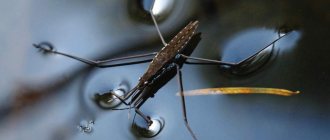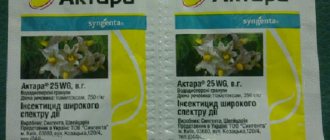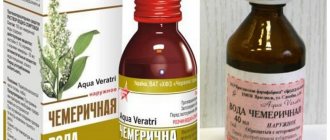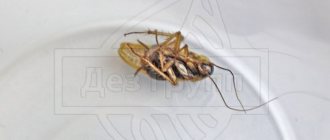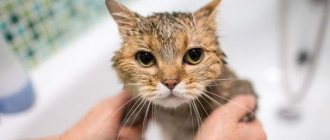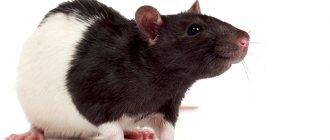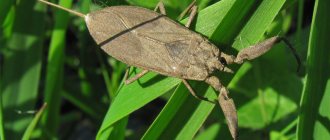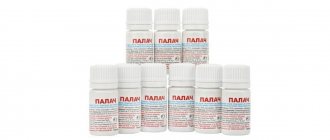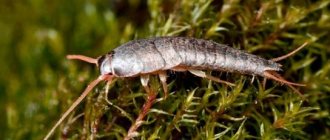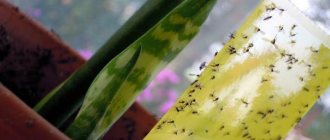Among aquatic bugs, the water scorpion family is characterized by the presence of grasping limbs and a breathing tube located at the end of the body. A real diversity of species can be found in the tropics; the two genera of choice in the Northern Hemisphere are Ranatra and Nepa. In the Palearctic, only 3 species of the genus Ranatra are found, one of them is Ranatra rod-shaped. Representatives of this group have an elongated body that looks like a praying mantis. Ranatralinearis is the largest bug in Europe.
Apathetic Cannibal
The ranatra received a comparison with a stick due to its long body ending in a long breathing tube of almost the same size.
Thanks to the snorkel, she, like a diver, can breathe underwater. True, not for long. That’s why ranatra swims and dives like a log – it just sluggishly moves under the water, clinging to the stems and leaves of underwater plants with its claws. In general, by nature, this water bug is terribly apathetic and unsociable - a real sociopath in the world of insects. It prefers to live and feed in stagnant or low-flowing reservoirs, because most of the time it is in standby mode, disguising itself as a dirty branch. Because of this, it is often compared to a praying mantis: the ranatra folds its pointed upper limbs in a similar way in anticipation of the victim - as if praying. She can remain in this position for several hours. But all you have to do is approach the gaping insect...
This aquatic bug has large eyes and has antennae and a proboscis. The body is covered with a hard cuticle, which protects it from aquatic parasites that look like bright red lumps.
If you're lucky
The ranatr family lays new life at the beginning of summer. Males attract females by making sounds by rubbing their legs against the surface of their chest.
Soon yellow larvae emerge from the eggs. They immediately look like adult insects, only without wings and a long breathing tube - it will appear only after the last molt. They will become full-fledged ranatras only after three months - if you're lucky. After all, only adults remain for the winter, and the larvae simply freeze.
Fish producers do not like ranatras: in large quantities they harm pond farming, sucking eggs and fry of commercial fish.
In many regions the alarm is already sounding: the number of this water bug has sharply decreased due to pollution of the aquatic environment, primarily with oily industrial waste, which makes it impossible for the insect to breathe with a tube.
Dossier Latin name: Ranatra Family: water scorpions Order: Hemiptera Body length: up to 3 cm Distribution: western part of the Palaearctic. In Russia it is recorded in the middle zone, in the south and north-west of the European part. Also found in Transcaucasia, Central Asia, Kazakhstan and Western SiberiaCharacter: closed, phlegmatic
Anna Morozova
Lifestyle
Ranatra rod-shaped inhabits stagnant and low-flow reservoirs. The insect is inactive in water. Spends most of its time frozen among aquatic vegetation. Due to the body structure and protective coloring, the bug looks like a thin twig. The water stick insect swims poorly, moves slowly with its legs, grabbing onto aquatic plants. It cannot catch up with prey; it catches invertebrates that are nearby. Adults attack tadpoles and fish fry. The predator rushes at any moving prey within its reach. Even when it is full, the stick insect continues to hunt and kill.
Reproduction
Adults are active from July to October and remain in water bodies for the winter. They prefer places with a sandy bottom and stay in shallow water. In October they migrate in search of a more suitable location. In rare cases, insects spend the winter on land.
The breeding season begins in late spring. During mating, the male has to interrupt the act to breathe air. Its breathing tube is located next to the genital capsule. The air duct has to be moved apart to allow procreation. The female lays eggs in the tissue of plants floating on the surface of the reservoir. The eggs are large, oval, at the end there are two thread-like processes for air intake. The female's fertility is 30 eggs.
After 2-3 weeks, larvae emerge from the eggs. At the first instar they are 7 mm long, yellow in color, and darken after molting. During development, the larva goes through five instars. The maximum body size is 35-36 mm. Externally, the offspring are similar to adult bedbugs, but do not have wings or a breathing tube. Before molting, the larva firmly clings to the plant with its paws. The tear in the old skin runs longitudinally across the back. The insect slowly crawls out through the gap, leaving a tight cover. While breathing, the larva rises to the surface of the water and touches it with its middle and hind limbs. They do not have a full-fledged siphon, only a small appendage.
The water stick insect is an insect with incomplete metamorphosis. Larvae do not transform into pupae. The water bug completes the entire development cycle from egg to adult in 3 months. The enemy of the rod-shaped ranatra is the chalcid, which lays its eggs on the offspring of the bug.
Small bug, but dangerous
Ranatra is a passive, but very cruel predator. It usually preys on tadpoles, mosquito larvae and other aquatic invertebrates. But large individuals can even attack fish. The author of the book “An Entertaining Aquarium” Mark Makhlin describes this interesting creature as follows:
“When the ranatra sits on a reed, you won’t notice it. A small fish or tadpole will swim up to a reed - and suddenly two “arms” will separate from the trunk and grab the gaping crumb. The bug can sit motionless for hours. But if you put him in a jar with fifty tadpoles, he will probably cope with them in an hour. Only, of course, he won’t be able to eat everyone, he will simply kill, throw to the bottom and grab the next one. It is the Ranatra that exhibits a kind of “grasping instinct”: many predators cannot tolerate the flashing of prey and kill it, even when well fed.”
Photo: yandex.uz
Determination of water pollution by aquatic animals and plants
The Psel River, like every body of water, is a complex living system inhabited by bacteria, algae, higher aquatic plants, and various invertebrate animals. The combination of their activities ensures the self-purification of water bodies. If, for example, chemical impurities enter a body of clean water, the self-purification process proceeds quickly, so one of the most important environmental tasks is to maintain this ability.
The factors for self-purification of reservoirs are diverse. Conventionally, they can be divided into three groups: physical, chemical, biological.
Among the physical factors, dilution, dissolution and mixing of incoming contaminants are of paramount importance. Good mixing and a decrease in the concentration of suspended particles is ensured by the intense flow of the Psel River. The self-purification of the reservoir is facilitated by the settling of insoluble sediments to the bottom, as well as the settling of polluted waters. Microorganisms, under their own weight or deposited on other organic or inorganic particles, gradually sink to the bottom and are exposed to physical factors, which contributes to the rapid death of polluting microflora. This process is inhibited by a decrease in water temperature, which favors the long-term preservation of bacteria and viruses that have entered the reservoir.
Water disinfection occurs under the influence of ultraviolet radiation from the sun. The disinfection effect is achieved by the direct destructive effect of ultraviolet rays on protein colloids and enzymes of the protoplasm of microbial cells, as well as on spore organisms and viruses.
Among the chemical factors of self-purification of reservoirs, oxidation of organic and inorganic substances should be noted. The self-purification of a reservoir is often assessed in relation to easily oxidized organic matter (determined by biochemical oxygen demand - BOD) or by the total content of organic matter (determined by chemical oxygen demand - COD). Self-purification is also assessed based on the content of specific compounds or their groups (phenols, hydrocarbons, resins).
I determined that the Psel River belongs to the second type of reservoir, i.e. used for swimming, sporting events and is also located within populated areas.
Biological factors of self-purification of a reservoir include algae, mold and yeast. However, phytoplankton does not always have a positive effect on self-purification processes: in some cases, the massive development of blue-green algae can be considered as a process of self-pollution.
Representatives of the animal world can also contribute to the self-purification of water bodies from bacteria and viruses. Thus, the oyster and some amides adsorb intestinal and other viruses. Each mollusk filters more than 30 liters of water per day. Comparing the number of mollusks with the pollution of the water basin, the environmental working group found that near the farm with. Cherenovo, where the density of shellfish - filtrates is insignificant, the water is more turbid.
Downstream, where the number of barley and toothless moths increases sharply and in some places reaches 150 specimens per 1 m2 of bottom, the turbidity increases by 70%.
In the course of her research, she established a slight shift in the species composition of the flora in favor of nitrophils, namely nettles and climbing deciduous thickets along the banks of the stream.
The purity of water in the river is indicated by indicator plants: white water lily, yellow water lily, black alder, willow, water lily, telores; animals: ruffe, perch, pike perch, pike, caddisfly larvae, toothless larvae, pearl barley...
The purity of the water in the Psel River can be explained not only by the complex physical and chemical processes occurring there, but also by the vitality of animal and plant organisms. The smallest algae absorb minerals and organic substances from water and, during the process of photosynthesis, release a huge amount of oxygen, which actively affects the decomposition of organic substances. This is how the self-purification of the Psel River occurs.
Useful "soldiers"?
Those who grow vegetables in their gardens are familiar with many pest bugs. An insect with a black and red pattern on its back, the wingless red bug is found in dry grass, lives on stumps and at the roots of trees. It eats eggs and larvae of insects, ants, and the remains of dead relatives, thus acting as a nurse on the site. But it's not that simple.
Belonging to the order Hemiptera, the soldier bug is mainly found in warm countries, but is also familiar to many on the European continent. Insect colonies begin to reproduce in the spring. Although it does not cause much harm to agriculture, on a personal plot, an overgrown family of red-black arthropods is quite capable of destroying young greens, cabbage, and sucking the juices from ripened grapes. For owners of farm plots, the harm is very noticeable.
Hydrobionts as indicators of surface water pollution with heavy metals
Natarov V.M., Savchenko V.V. Berezinsky Biosphere Reserve, Domzheritsy village, Belarus Ministry of Natural Resources and Environmental Protection, Minsk, Belarus
Hydrobionts are the most studied and used organisms as bioindicators of environmental pollution. Analysis of literature data shows that in aquatic ecosystems, representatives of a wide variety of life forms, nutrition types and consumer levels can serve as animals suitable for these purposes. Aquatic organisms are more dependent on environmental conditions than mammals and birds. The absorption of heavy metals, most of which are vital trace elements (EME), occurs not only with food, but also during respiration and through the external integument.
As organisms - bioindicators of metal pollution of ecosystems
Berezina - 3 species of fish of different trophic levels were used - plankton-benthosophages (roach), the entire ontogenetic cycle of which mainly takes place in the surface layers of water, and predators - perch and pike (in the diet of the first, along with fish, an important place belongs to benthic organisms; diet pike consists exclusively of fish). For the same purpose, two types of mollusks (reel and pond snail) were used, which are food sources for birds and fish, which makes them important objects of biomonitoring.
The MCE content was determined only in the muscle tissues of fish and the body of mollusks. Nine MCEs of Pb, Cd, Zn, Cu, Cr, Mo, Sn, Mn and Ni, which are the most dangerous and well-studied pollutants of surface waters, are considered.
Comparison of the FEA composition of fish tissues showed a gradual increase in the concentrations of Zn, Cu, and, to a lesser extent, Cr from fish whose diet is dominated by planktonic and benthic organisms to carnivorous fish (table), which naturally reflects the concentrations of these pollutants in the trophic chain. Mn and Sn, on the contrary, accumulate more intensely in the muscles of planktivores and decrease in the tissues of predatory species. Ni and Pb were found in only one roach specimen.
Table
Content of microelements in biological objects of the Berezina River, mg/kg abs. dry in-va (August 1998)
| View | Pb | Cd | Zn | Cu | Cr | Mo | Sn | Mn | Ni |
| Pike | — | 0,03 | 22 | 0,46 | 0,21 | — | — | 0,61 | — |
| Perch | — | 0,09 | 15 | 0,41 | 0,14 | — | — | 0,86 | — |
| -//- | — | 0,09 | 17 | 0,30 | 0,11 | 0,14 | 0,15 | 0,25 | — |
| -//- | — | 0,09 | 20 | 0,37 | 0,09 | — | — | 0,20 | — |
| Roach | — | 0,09 | 12 | 0,29 | 0,11 | — | 0,40 | 1,19 | 0,02 |
| -//- | 0,05 | 0,08 | 8,3 | 0,20 | 0,11 | — | 0,16 | 2,05 | — |
| -//- | — | 0,05 | 9,3 | ,023 | 0,11 | — | 0,16 | 0,65 | — |
| Coil | — | — | 14 | 2,0 | 0,10 | — | — | 175 | — |
| Prudovik | — | — | 12 | 3,2 | 0,13 | — | 0,14 | 182 | 0,075 |
Very high concentrations of Mn, Cu and Zn are found in the body of mollusks - organisms belonging to lower trophic levels. The Cu content in mollusks is an order of magnitude higher, and the Mn content is several orders of magnitude higher than in fish, which is obviously due to their consumption of phytoperiphyton plants and detritus enriched with MCE.
Thus, when using fish and shellfish as biological indicators of MCE pollution of surface waters, it must be borne in mind that the accumulation mechanisms of representatives of the two trophic levels are significantly different. Each bioindicator gives a specific conclusion about water pollution with metals, but they characterize different parts of aquatic ecosystems.
It is important to note that in the protected Berezina, the accumulation of MCEs in the muscles of fish and the body of mollusks is very small compared to rivers of comparable size in other regions. Published on page
328-329
Published on pages 328-329.
Diptera insect larvae
The most numerous insect larvae in ponds are from the order Diptera, or flies. They inhabit not only the bottom of the reservoir, thickets of aquatic plants and the water column, but also live on the shore, and at the water’s edge, and in the roots of coastal plants, and deep in the silt.
The bottom of the reservoir is usually inhabited by animals with the common name bloodworms. These are the larvae of bell-bellied mosquitoes (family Chironomus). Their body is long, elongated and slightly flattened. Some species are red in color, others are green. Body length is 25-30 mm.
Bloodworms are a common food for many fish species. The larvae themselves primarily feed on microorganisms inhabiting the sludge.
The larvae of fly flies (bee flies) (family Syrphidae) are called “rats”. They are widespread in polluted stagnant bodies of water and puddles. Their body is short, unclearly segmented, with translucent skin. At the end of the body there is a very long process (breathing tube).
The larvae of numerous true or blood-sucking mosquitoes (Culicidae): squeaks (culex), malarials spend their entire lives in the water column at the very surface. Most of the time they hang on the surface film, feeding on organic particles and small aquatic organisms. They breathe through breathing holes brought to the surface at the end of the abdomen. As they grow up, they turn into pupae, which also float on the surface of the water.
Squeak mosquito larva
All these larvae provide food for numerous aquatic predators: beetles, fish, and amphibians.
References
Plants and animals of water bodies: A manual for students of pedagogical universities and school teachers. / O.N. Chernyshova, L.N. Erdakov, S.E. Dovbnya. - Novosibirsk: Knizhitsa, 1999.
Morphological description of the species
The species of water bugs Ranatralinearis belongs to the family of water scorpions. Another name for the insect is the water stick insect. The body is narrow, cylindrical in shape. The abdomen ends in a respiratory tube 20 mm long. The body size of females is 35-44 mm, males are smaller - 33-35 mm. The color is yellowish-gray, the upper part of the abdomen is red, the sides are yellow. The head is small, most of it is occupied by large compound eyes in the shape of a ball. There are short antennae of three segments. The proboscis is free, piercing-sucking, extending from the anterior edge of the head. The strong organ is directed forward and slightly downward.
Ranatra belongs to the order Hemiptera, its fore wings are half leathery. They completely cover the abdomen. The hind wings are wide, transparent, milky white. Folds only along the body. The wings are well developed, insects make confident and long flights. The prothorax is elongated, slightly narrowed in the middle.
The bug's scent glands are located in the metathorax; the secretion comes out between the coxae of the hind limbs. A characteristic feature of the species is that the front legs have transformed into grasping limbs. They lost thickened thighs, claws on the paw, and the lower leg was significantly reduced. The middle and hind legs are walking and are used to move on land.
Parasites
The body of the bug is covered with a hard cuticle. A durable shell is necessary to protect against parasitism by water mites. Significantly fewer mite larvae were observed on ranatra than on other aquatic hemipterans. Parasites concentrate on the lower part of the body, at the base of the limbs.
Breath of a water stick insect
The breathing tube or siphon consists of two halves, widened at the base. They form an air channel lined with hairs from the inside. Water doesn't get into it. The breathing process occurs as follows: the ranatra, holding the stem of the plant, hangs upside down, and sticks the tube out of the water. The air is directed through the grooves to the spiracles. Representatives of aquatic scorpions have 8 pairs of abdominal spiracles and 2 pairs of thoracic spiracles. Through the tube, air is directed to the eighth pair of spiracles. According to the tracheal system, it passes into the first pair and accumulates under the elytra.
Predators
Some varieties of house bugs have many similar traits, such as a hatred of feeding on plants. One of the varieties is predators, quite dangerous rubbish. Raptors are so named because they eat small insects and larvae. These bugs are more difficult to find in rural areas than the turtles mentioned above.
One interesting fact: these parasites wage an irreconcilable feud with bedbugs. Just like the Montagues and the Capulets! For the most part, they also live in houses and apartments, although they are fairly damaged by age. In general, initially these malicious creatures were found in South America, but time passes, and now they have already “mastered” a good half of Europe!
Here are the most vile predators:
- Reduvius mummer.
- Triatomine bug.
- Ringed predator.
Exactly! It's time to post a photo so that you can visually learn more about this type of bedbug!
Reproduction and development of bedbugs
Having appeared in the fields, female bugs - turtles begin to lay eggs on the underside of the leaves of the shoots in batches of 10 - 20 eggs. Over the course of a month, females lay eggs several times, ranging from dozens to 200 eggs.
After just ten to ten days, the eggs hatch into larvae that are similar to adult bedbugs, but smaller in size and without wings. After three to five days, the larvae molt, crawl through the bushes and begin to grub.
After five molts, the larvae hatch on adult bedbugs. The larval stage of the turtle lasts 35 - 40 days. The bedbug does not go through the fry stage.
For bedbugs and other comas, there are characteristic developments with incomplete transformations. With this development, the larvae are similar to adult comas, and the lyph stage is a day old.
In the steppe smoothie, turtle bugs disappear from the field right up to the harvest. Soon after the grain is harvested, the stinks move to the place in winter and spring, when the leaves fall from the trees, they hover under them until spring.
